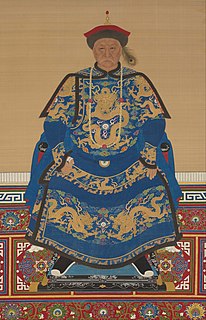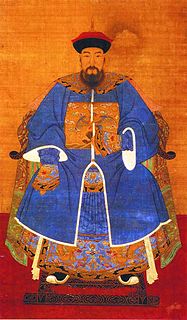Related Research Articles
The Eight Banners were administrative and military divisions under the Later Jin and the Qing dynasty of China into which all Manchu households were placed. In war, the Eight Banners functioned as armies, but the banner system was also the basic organizational framework of all of Manchu society. Created in the early 17th century by Nurhaci, the banner armies played an instrumental role in his unification of the fragmented Jurchen people and in the Qing dynasty's conquest of the Ming dynasty.

The Kangxi Emperor was the third Emperor of the Qing dynasty, and the second Qing emperor to rule over China proper, reigning from 1661 to 1722.

The Shunzhi Emperor was Emperor of the Qing dynasty from 1644 to 1661, and the first Qing emperor to rule over China proper. A committee of Manchu princes chose him to succeed his father, Hong Taiji (1592–1643), in September 1643, when he was five years old. The princes also appointed two co-regents: Dorgon (1612–1650), the 14th son of the Qing dynasty's founder Nurhaci (1559–1626), and Jirgalang (1599–1655), one of Nurhaci's nephews, both of whom were members of the Qing imperial clan.

Hong Taiji, sometimes written as Huang Taiji and sometimes referred to as Abahai in Western literature, was the second khan of the Later Jin and the founding emperor of the Qing dynasty. He was responsible for consolidating the empire that his father Nurhaci had founded and laid the groundwork for the conquest of the Ming dynasty, although he died before this was accomplished. He was also responsible for changing the name of the Jurchen ethnicity to "Manchu" in 1635, and changing the name of his dynasty from "Great Jin" to "Great Qing" in 1636. The Qing dynasty lasted until 1912.

Oboi was a prominent Manchu military commander and courtier who served in various military and administrative posts under three successive emperors of the early Qing dynasty. Born to the Guwalgiya clan, Oboi was one of four regents nominated by the Shunzhi Emperor to oversee the government during the minority of the Kangxi Emperor. Oboi reversed the benevolent policies of the Shunzhi Emperor, and vigorously pushed for clear reassertion of Manchu power over the Han Chinese. Eventually deposed and imprisoned by the new emperor for having amassed too much power, he was posthumously rehabilitated.
Hešeri, is a clan of Manchu nobility with Jianzhou Jurchens roots, originally hailing from the area which is now the modern Chinese provinces of Jilin and Liaoning. It was once one of the most important and powerful noble families in the early Qing dynasty in China, second only to the royal House of Aisin Gioro, to whom they were closely related by marriage.

Amban is a Manchu language term meaning "high official", corresponding to a number of different official titles in the imperial government of Qing China. For instance, members of the Grand Council were called Coohai nashūn-i amban in the Manchu language and Qing governor-generals were called Uheri kadalara amban.
Hyojong of Joseon was the seventeenth king of the Joseon Dynasty of Korea from 1649 to 1659. He is best known for his plan for an expedition to the Manchu Qing dynasty, and his campaigns against the Russian Empire at the request of the Qing dynasty. His plan for the northern expedition was never put into action since he died before the campaign started.
Yishan, courtesy name Jingxuan, was a Manchu lesser noble and official of the Qing dynasty. He is best known for his failure to defend Guangzhou (Canton) from British forces during the First Opium War, and for signing the treaties of Kulja and Aigun with the Russian Empire in 1851 and 1858 respectively.

The Sino-Russian border conflicts (1652–1689) were a series of intermittent skirmishes between the Qing dynasty, with assistance from the Joseon dynasty of Korea, and the Tsardom of Russia by the Cossacks in which the latter tried and failed to gain the land north of the Amur River with disputes over the Amur region. The hostilities culminated in the Qing siege of the Cossack fort of Albazin (1686) and resulted in the Treaty of Nerchinsk in 1689 which gave the land to China.
The Qing dynasty (1636–1912) of China developed a complicated peerage system for royal and noble ranks.

Hong Chengchou (1593–1665), courtesy name Yanyan and art name Hengjiu, was a Chinese official who served under the Ming and Qing dynasties. He was born in present-day Liangshan Village, Yingdu Town, Fujian Province, China. After obtaining the position of a jinshi in the imperial examination in 1616 during the reign of the Wanli Emperor, he joined the civil service of the Ming Empire and served as an official in Shaanxi. During the reign of the Chongzhen Emperor, he was promoted to Minister of War and Viceroy of Suliao. In 1642, he surrendered and defected to the Manchu-led Qing Empire after his defeat at the Battle of Songjin. He became one of the Qing Empire's leading Han Chinese scholar-politicians. While he was in office, he encouraged the Manchu rulers to adopt Han Chinese culture and provided advice to the Qing government on how to consolidate its control over the former territories of the fallen Ming Empire. Apart from Dorgon and Fan Wencheng (范文程), Hong Chengchou was regarded as one of the most influential politicians in the early Qing dynasty. However, he was also villainised by the Han Chinese for his defection to the Qing Empire and for his suppression of the Southern Ming dynasty.

Khatanbaatar Magsarjav was a Mongolian general and a leading figure in Mongolia's struggle for independence. His contingent of 800 elite Mongol soldiers fought White Russian and Chinese forces over 30 times between 1912 and 1921, without a single defeat. He served as acting prime minister from February 15, 1921 to March 13, 1921, under Roman Ungern von Sternberg's puppet regime and then later as minister of the army in the 1920s. He received the title Ardyn (Ардын) in 1924.

Booi Aha is a Manchu word literally meaning "household person", referring to hereditarily servile people in 17th-century Qing China. It is often directly translated as "bondservant", although sometimes also rendered as "slave" ("nucai").
Šarhūda, known also under the Chinese transcription of his name, Shaerhuda, was a Manchu military commander during the early Qing dynasty, active both before and after the Manchus seized control of China.

The flag of the Qing dynasty was an emblem adopted in the late 19th century featuring the Azure Dragon on a plain yellow field with the red flaming pearl in the upper left corner. It became the first national flag of China and is usually referred to as the "Yellow Dragon Flag".
Amin was a Manchu noble and an important military and political leader in the early years of the Qing dynasty.

The Russian invasion of Manchuria occurred in the aftermath of the First Sino-Japanese War (1894–1895) when concerns regarding China's defeat by the Japanese and the latter's occupation of Manchuria caused the Russians to speed up their long held designs for imperial expansion across Eurasia.
Anfiyanggū, , was a Manchu official and one of the earliest companions of Nurhaci.

The Qing dynasty (1636–1912) was established by conquest and maintained by armed force. The founding emperors personally organized and led the armies, and the continued cultural and political legitimacy of the dynasty depended on the ability to defend the country from invasion and expand its territory. Therefore, military institutions, leadership, and finance were fundamental to the dynasty's initial success and ultimate decay. The early military system centered on the Eight Banners, a hybrid institution that also played social, economic, and political roles. The Banner system was developed on an informal basis as early as 1601, and formally established in 1615 by Jurchen leader Nurhaci (1559–1626), the retrospectively recognized founder of the Qing. His son Hong Taiji (1592–1643), who renamed the Jurchens "Manchus," created eight Mongol banners to mirror the Manchu ones and eight "Han-martial" banners manned by Chinese who surrendered to the Qing before the full-fledged conquest of China proper began in 1644. After 1644, the Ming Chinese troops that surrendered to the Qing were integrated into the Green Standard Army, a corps that eventually outnumbered the Banners by three to one.